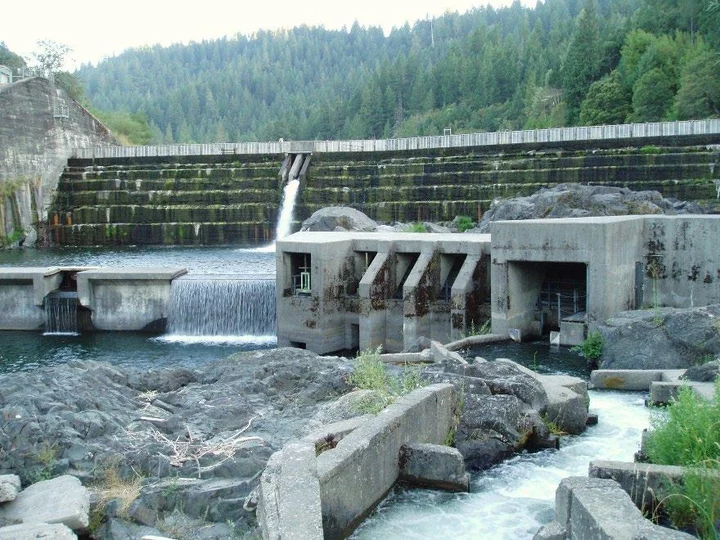Cape Horn Dam. Photo: PG&E.
PREVIOUSLY:
- Humboldt Supervisors OK Potter Valley Water Diversion Plan, Paving the Way for Eel River Dam Removal
###
Press release from PG&E:
On July 24, PG&E filed its Surrender Application and Decommissioning Plan for the Potter Valley Project with the Federal Energy Regulatory Commission (FERC). PG&E previously made available two drafts for public comment. FERC will now review the application and in the process will seek input from all interested parties through its open and transparent public comment period. In addition, the public will have opportunities to participate in FERC’s National Environmental Policy Act (NEPA) review and the California State Water Resources Control Board’s (SWRCB) California Environmental Quality Act (CEQA) review through their public comment processes.
Furthermore, with the application filed, PG&E will begin the process of developing management and construction plans that will further detail the decommissioning process and aspects of the project.
“Today’s filing marks the next step of a thoughtful and transparent decommissioning journey for the Potter Valley Project—but it does not change our operational responsibilities or obligations,” said Dave Gabbard, vice president of power generation for PG&E. “We remain fully committed to meeting all current FERC requirements as we work through the decommissioning up until the license is terminated by FERC. As stewards of public resources and partners to the communities we serve, our priority is clear: to move forward responsibly, collaboratively, and with the continued reliability our stakeholders expect.”
The FERC submittal includes a request to allow the Eel-Russian Project Authority (ERPA) to construct the New Eel-Russian Facility (NERF) at the current location of Cape Horn Dam. The NERF will provide diversion flows from the Eel River to the Russian River watershed after PG&E’s removal of Cape Horn Dam and Scott Dam. The removal of the two PG&E dams will allow fish to access habitat in the Upper Eel River watershed.
“Decommissioning the Potter Valley Project and removing the dams is in the best interest of our customers,” said Dave Canny, vice president of PG&E’s North Coast Region. “We recognize that change of this magnitude is significant, and we are proud of our work with ERPA. We believe that the NERF proposal provides a good path forward for all communities. We are committed to serving customers in the North Coast for many years to come.”
The Potter Valley Project in Mendocino and Lake counties has a long history of generating renewable power and providing water from the main stem of the Eel River to Potter Valley and the Russian River, which has extensively benefited agriculture and communities along the Russian River. The Potter Valley Project consists of Cape Horn Dam and Van Arsdale Reservoir (built in 1908), Scott Dam and Pillsbury Reservoir (built in 1922), and other facilities such as the powerhouse and water conveyance tunnels. A fish passage structure and salmon and steelhead counting station was also constructed at the Cape Horn Dam site.
While salmon and steelhead are able to use a fish passage structure to navigate around Cape Horn Dam, the migratory fish are currently unable to move above Scott Dam.
As its infrastructure continued to age, and after years of internal analysis, it was determined the Potter Valley Project was uneconomical for PG&E’s customers. In 2019, PG&E informed FERC it would not pursue a renewed operating license. However, understanding that many communities rely upon the facility’s water supply and diversion benefits, the company devoted years working with various external entities on a potential alternative to transfer the project to new ownership.
Ultimately, no new prospective owner filed an application to license the project with FERC, which led FERC to direct PG&E to submit a surrender application and decommissioning plan.
The Potter Valley Project has been important to local communities, tribes, agricultural interests, and environmental interests for over 100 years. PG&E has publicly committed to an open, respectful process that strives to balance the needs of many interested entities.
As PG&E moves forward with plans to decommission and eventually remove Cape Horn and Scott dams, PG&E continues to coordinate closely with parties to support a new water diversion facility, including Sonoma County Water Agency, Inland Water & Power Commission of Mendocino County, Round Valley Tribes, Humboldt County, Cal Trout, Trout Unlimited and California Department of Fish & Wildlife.
Throughout the decommissioning process, PG&E will continue to operate the Potter Valley Project in compliance with all existing FERC requirements, including recreation, minimum in-stream flows, water diversions, etc.
Included in the Surrender Application and Decommissioning Plan (SADP) is a request for FERC to authorize PG&E to permit the “Non-Project Use of Project Lands” which will allow ERPA to construct the NERF, while utilizing some of the existing Potter Valley Project facilities.
While PG&E strongly believes this coordinated effort is the best path forward, ERPA will be responsible for the construction, operation, and maintenance of the NERF. The close coordination between PG&E and ERPA is critical to ensure the construction of the NERF will not delay the decommissioning of the Potter Valley Project and will allow for a smooth transition to ERPA operations. The timing will follow the FERC process for approval.
With the SADP now filed with FERC, the official FERC proceeding will begin. A public comment period of 30 days will be led by FERC, and the timing of that comment period will be determined by FERC and announced via their distribution list. To be added to the FERC distribution list for the Potter Valley Project visit FERC’s website and follow the steps outlined.: eSubscription | Federal Energy Regulatory Commission.
###
On Aug. 11, from 3 to 5 p.m., PG&E will host an online meeting to share information on the SADP, discuss the overall regulatory process, and public participation opportunities in the regulatory processes. Learn more.
###
DOCUMENT:

CLICK TO MANAGE